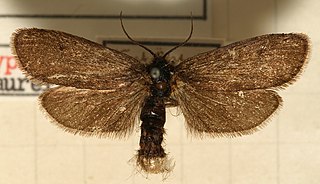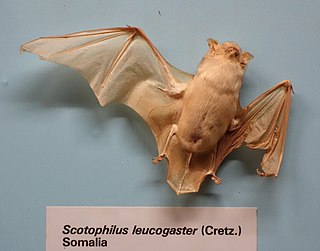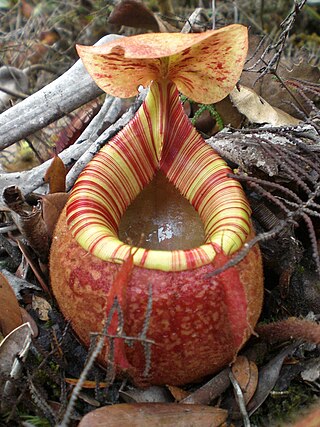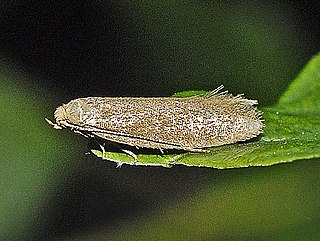
The Angolan slender mongoose is a mongoose native to southwestern Africa, specifically southwestern Angola and northwestern Namibia. It has been listed as "Least Concern" on the IUCN Red List, as it is not threatened and thought to be common. It has a long, slim body and there are different colour forms, a black or dark brown form in the southern part of its range, and a yellowish- or reddish-brown form in the north. This mongoose inhabits dry, rocky habitats and feeds on insects, scorpions and small vertebrates.

Lypusidae is an obscure family of moths placed in the superfamily Gelechioidea.

Genoways's yellow bat is a species of vesper bat found only in Mexico. It is threatened by habitat loss. Due to its imperiled status, it is identified by the Alliance for Zero Extinction as a species in danger of imminent extinction.

The white-bellied yellow bat or white-bellied house bat, is a species of vesper bat in the genus Scotophilus, the house bats. It can be found in Angola, Benin, Botswana, Burkina Faso, Cameroon, Central African Republic, Chad, Ivory Coast, Gambia, Ghana, Guinea, Guinea-Bissau, Kenya, Mali, Mauritania, Namibia, Niger, Nigeria, Senegal, Sierra Leone, Sudan, Togo, Uganda, and Zambia. It is found in dry and moist savanna and open woodland. It is a common species with a very wide range, and the International Union for Conservation of Nature has assessed its conservation status as being of "least concern".

The bar-backed partridge, also known as the brown-breasted hill-partridge, is a species of partridge in the family Phasianidae. It is found in southwestern China and Southeast Asia.

The swamp musk shrew, or musk shrew, is a species of mammal in the family Soricidae. It occurs in Angola, Botswana, Democratic Republic of the Congo, Mozambique, Namibia, South Africa, Eswatini, Zambia and Zimbabwe. Its natural habitat is swamps, and it is a common species in suitable habitats, with the International Union for Conservation of Nature listing it as being of "least concern".

Kihaule's mouse shrew is a species of mammal in the family Soricidae endemic to Tanzania where it is known only from the Udzungwa Mountains, at the western end of the Eastern Arc Mountains. Its natural habitats are subtropical or tropical moist montane forests and plantations. It is threatened by habitat destruction and the International Union for Conservation of Nature has assessed its conservation status as being "endangered". It was named after Philip M. Kihaule, a medical-entomological technician, who considerably contributed to the documenting of the small mammals of Tanzania and collected the type specimen of this shrew.

The Kolar leaf-nosed bat, or leafletted leaf-nosed bat is a species of bat in the family Hipposideridae. It is endemic to India. Its natural habitats are subtropical or tropical dry forests and caves. It is found in only one cave in India, and its population is less than 200 individuals.

Nepenthes peltata is a tropical pitcher plant known only from the upper slopes of Mount Hamiguitan on the island of Mindanao in the Philippines. It is characterised by a peltate tendril attachment and conspicuous indumentum. The species typically produces ovoid pitchers with a prominent basal crest and large nectar glands on the lower surface of the lid.

Arctostaphylos pallida, commonly known as pallid manzanita, Oakland Hills manzanita, and Alameda manzanita, is an upright manzanita shrub from the Ericaceae, or heath family. It is endemic to the eastern San Francisco Bay Area of Northern California.

Eristalinae are one of the four subfamilies of the fly family Syrphidae, or hoverflies. A well-known species included in this subfamily is the dronefly, Eristalis tenax.

Pseudatemelia subochreella, the straw-coloured tubic, is a species of gelechioid moth.
Tokary is a village in the administrative district of Gmina Przodkowo, within Kartuzy County, Pomeranian Voivodeship, in northern Poland. It lies approximately 6 kilometres (4 mi) north-east of Przodkowo, 13 km (8 mi) north-east of Kartuzy, and 21 km (13 mi) west of the regional capital Gdańsk.
Hiranaam is a form of Sattriya music related to the Vaishnava religious scriptures. The singers, the Gayans accompany themselves with cymbals played by the Bayans. The singing mainly involves chanting the names of Krishna, in a call and response style.

Lypusa is a genus of moths of the Lypusidae family, traditionally held to be a monotypic lineage of Tineoidea. However, it may actually belong to the same lineage of Gelechioidea as the Amphisbatinae.

Lypusa maurella is a moth of the Lypusidae family. It is found in most of Europe.
Napu is an Austronesian language spoken in the North Lore district of Central Sulawesi, Indonesia. Together with Bada and Behoa, it belongs to the Badaic subgroup.
The Japanese short-tailed bat is a species of bat belonging to the family Vespertilionidae. It is endemic to Japan where it is found at the base of the northern Japanese Alps, the Chichibu Mountains and Oze National Park, mostly at altitudes higher than 700 m.

The long-tailed shrew or rock shrew is a small shrew found in Atlantic Canada and the Northeastern United States.

The Tokari is a stringed instrument played with the fingertips. The Tokari is the most widely used and popular stringed instruments in different parts of Assam. It is an ancient folk instrument of Assam. The instrument is usually made by covering a shell of Mango or Cham wood with the skin of a goat. It has many similarities to the "Dotara", another such folk instrument prevalent in southern Assam. The Tokari is slightly larger and wider than the Dotora. It also has many similarities to the Ruan, a Chinese musical instrument.














